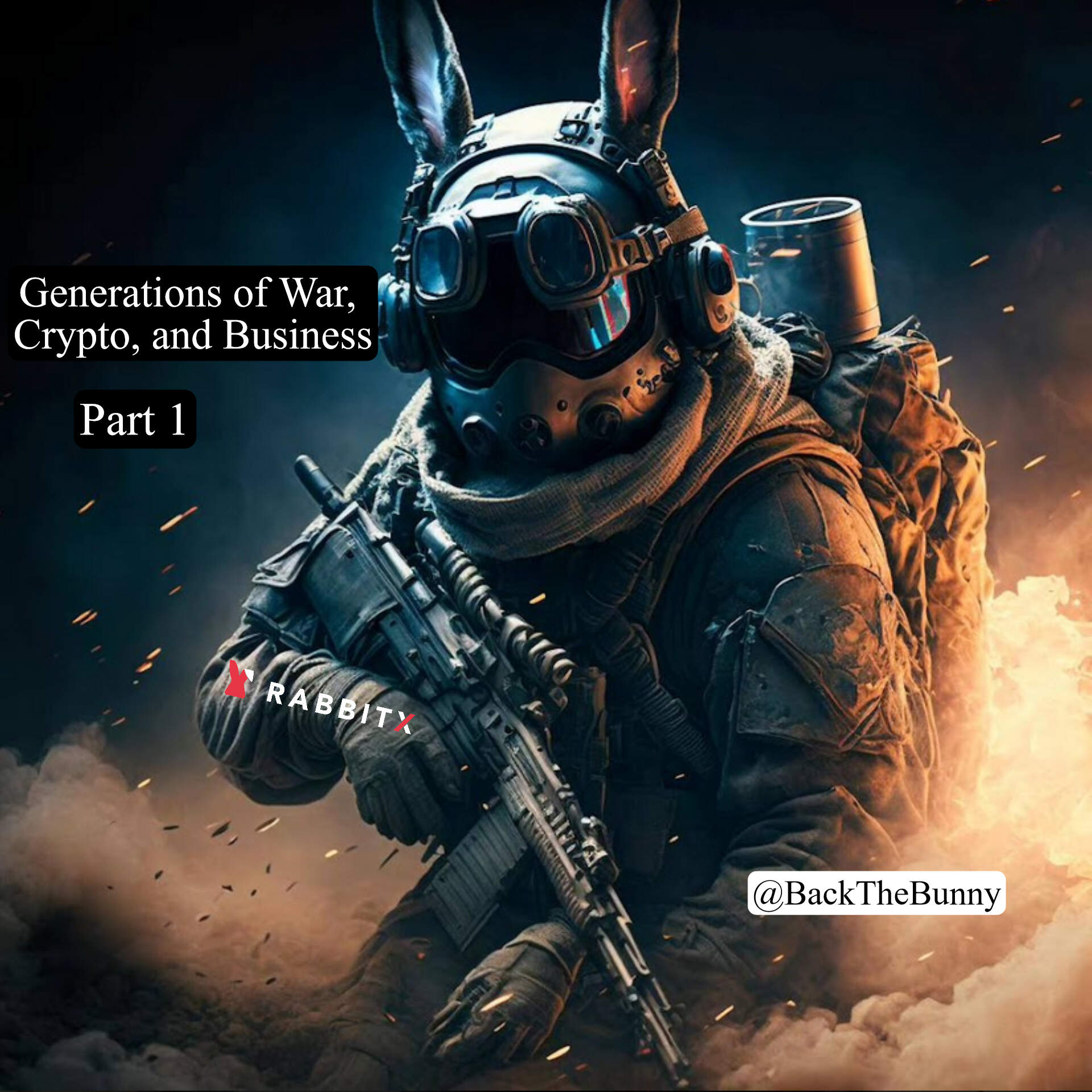Generations of warfare and business correlate closely with each other. However, there is a lag between the two. Warfare is roughly one cycle ahead of business.
Out of game-theoretic necessity, war is more adaptive to new tactics. Using militaries as a leading indicator, you can anticipate emergent business behaviors. Warfare management is compelled to evolve to new strategies more readily, motivated not by profit but by survival. So military management typically leads, albeit imperfectly.
Crypto is speed running financial history. DeFi is the most rapidly evolving economic system the world has ever known (if you have a counterpoint to this I’d love to hear it). Where is DeFi in its process when compared with business and war? And using warfare as a leading indicator, what can we expect for DeFi’s future generations?
The following is part one of a four-part series that analyzes business and warfare generations and draws parallels and predictions for DeFi’s past, present, and future.
1ST GENERATION
1st-Gen Business:
1st-gen business coincides with 1st-gen warfare but is more medieval in its operations (remember warfare is always one cycle ahead of the business cycle it coincides with). During this time, business was often conducted through trade and merchant guilds; meaning groups of merchants in the same industry working together to regulate prices and protect their interests. 1st-gen business was subject to control by feudal lords, the state, and the Catholic Church. The church owned a lot of land and had a monopoly on certain trades.
1st-Gen Warfare (one cycle ahead):
1st-gen warfare was a departure from medieval strategies, and utilized linear tactics with line-and-column techniques in direct combat, with muskets and conscripted armies.
It began to see emergent centralization, with professional officers leading armies of full-time, uniformed, paid soldiers fighting for nations instead of feudal lords. More tactical organization was limited by inferior communications and intelligence capabilities.
1st-Gen Crypto (not yet DeFi):
Crypto’s 1st gen begins at the creation of Bitcoin in 2009. It introduced the concept of decentralized assets that exist purely in digital space, having value both via a market price and by way of remitting payments with no central intermediary. Crypto’s 1st gen is somewhat medieval, like its business counterpart, in that it facilitated simple transactions to and from users, with no real strategic ability beyond basics. The 10,000 BTC purchase of a pizza encapsulates the pre-DeFi era of crypto well. This generation lasted from 2009-2015.
2ND GENERATION
2nd-Gen Business:
Similar to 1st-gen warfare, 2nd-gen business includes paycheck employees and a structured approach to business operations. It had more coordinated centralization manifest, with large business empires beginning to form and supersede colonial ones. Its communications were improved but limited, consisting of primitive forms like mail and telegraph. You begin to see the professional and strategic structures for it to build upon in future generations.
2nd-Gen Warfare (one cycle ahead):
2nd-gen warfare featured technological advancements that made war more lethal. The machine gun was introduced, and it relied on raw firepower and manpower to wear away at the enemy and then occupy his territory. Attrition warfare was the hallmark strategy, and the side with greater economic resources was usually victorious. War was still fought face to face, and compared to 3rd-gen war, with a sense of decorum. ‘War crimes’ were not really a thing, and there was still a sense of acceptable war behavior.
Some key features were fixed fortifications, artillery, and the adoption of more organized strategy. Brute force and facing the enemy were how the game was played. Coordination was enhanced by advancements in communication from things like the telegraph.
2nd-Gen Crypto, now DeFi:
The emergence of the smart contract and Ethereum in 2015 marks the beginning of crypto’s 2nd generation and evolution into DeFi.
Onchain smart contracts facilitated greater coordination and interaction. This created the substrate for more sophisticated transactions and infrastructure for a financial ecosystem beyond simple remittances. The smart contract is the basis for communication that allowed new forms of financial strategizing to be built on (smart contracts are simply programmatic, automated instantiations of communication). Ethereum and other programmable base layers allowed DeFi to organize itself more effectively and later, strategically. Being able to send, issue, borrow, lend, and trade all manner of crypto spawned an entirely new market of projects offering many kinds of financial services. 2nd-gen DeFi lasts from 2015-2020.
3RD GENERATION
3rd-Gen Business:
Professional managers began to exert more complete control, and competition had the trench-warfare attrition characteristics of 2nd-gen warfare. Competitors that were evenly matched attempted to wear each other out in the market, with the entity with greater financial resources having substantial advantage. There was a strong emphasis on meeting the needs and expectations of customers and building longer-term relationships.
Business centralization and size seems to peak in the 3rd-gen with the advent of the conglomerate. Mega corporations creating empires of disparate businesses becomes something of a trend. This is one of the least-efficient elements of this generation, and begins to get unbundled in the 4th gen.
3rd-Gen Warfare (1 cycle ahead)
3rd-gen warfare, also known as Blitzkrieg or maneuver warfare, was inspired by the German military. It relies heavily on speed, mobility, stealth, and surprise to outmaneuver the enemy and attack from within rather than confront and erode him away slowly (attrition). It embraced ‘total war’, which involved the mobilization of societies, as countries sought to harness the resources of their population for victory.
It disregarded notions of honor or fairness, embracing deception and brutal pragmatism as valid tactics. 3rd-gen atrocities result in the creation of things like UN war crimes. Notable new technologies include widespread use of armored units, tanks, planes, and paratroopers.
3rd-Gen DeFi (where DeFi is now)
DeFi is in the midst of its 3rd generation, beginning in 2021 after DeFi Summer in 2020. Ethereum continues to become the Lindy baselayer and dominates from its network effects, allowing DeFi to scale from niche financier playground to infrastructure that seriously threatens the existence of bank and state cartels.
Like 3rd-gen warfare, an array of new technologies that allow more sophisticated transactions, scaling, and disintermediation (maneuvering) of gate-keeping middlemen are rapidly being developed, with ZK rollups being the most prominent example. DeFi operates with vastly disproportionate speed than its enemy, who's glacial to adapt but forceful when it finally attacks.
The attack on Tornado Cash and the state’s hostility as it realizes DeFi disintermediates its relationship with money has started DeFi’s guerilla phase (this will have a lot of parallels to 4th-gen warfare). Anon teams will become more common and extreme privacy measures are increasingly critical. The arrest and infinite detention of Tornado developer Alexey Pertsev (with no charges) has opened the eyes of DeFi builders that this is going to be both a technological and ideological war. The state will use selective tactics to attack its enemy and DeFi will respond in kind, but only with defensive measures in its 3rd gen.
3rd-gen DeFi ends when Western VCs can only fund fully doxxed teams with official business presences in Western states. Meaning formal involvement with DeFi in the US and its vassals must be KYC’d. The US will become increasingly draconian and erratic, lashing out inconsistently and aggressively, as it has the most to lose from DeFi’s proliferation. The US will see a braindrain in the DeFi space as a result. Crypto natives will begin renouncing their US citizenship and distancing themselves from an openly hostile, declining power.
This concludes part one. In part two I'll review 4th-generation warfare and business and use it to extrapolate where DeFi is headed from a tactical and ideological standpoint. Be advised, it gets kinda dark.
Follow at @BackTheBunny
Check out another popular post --> Predicting Recessions: What Yield Curves Tell Us About the Future Demand for Money



Reading your article has greatly helped me, and I agree with you. But I still have some questions. Can you help me? I will pay attention to your answer. thank you.